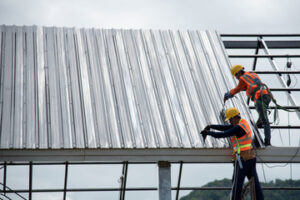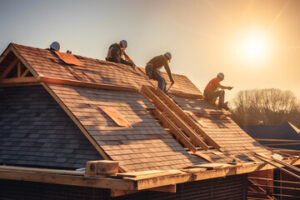Getting a new roof is a major investment and can greatly enhance your home’s value. Understanding the roofing process can help you choose a contractor that best meets your needs and budget.

Asphalt shingles are relatively easy to install and are a popular choice for homeowners. They are available in a wide range of colors and styles. Visit https://www.bostonroofingco.com/ to learn more.
There are a variety of materials that can be used to roof your home. The most common are asphalt shingles, which offer good value and are easy to install. Other roofing materials include clay tiles, concrete tiles and slate. Each offers a different style and appearance to your home, but all are more durable than shingle options. Some can even withstand high winds and are ideal for areas that receive heavy rainfall.
Depending on the material type, your new roof may require a variety of other construction materials and tools for installation. In addition to the roof sheathing, you will need underlayment to protect the underlying layers and keep water from infiltrating your home. The underlayment is laid before the shingles and will typically consist of two to three layers of paper and liquid asphalt. It is best to begin the underlayment at the eave, overlapping it with the ice and water protector by 4 inches and the valley membrane flashing by 6 inches.
The underlying layer of the roof sheathing, known as roof decking, provides structural support for the shingles and other roofing materials. It is a crucial part of the entire roof system and helps prevent structural problems like sagging or bowing. Typical roof sheathing materials include plywood and oriented strand board (OSB), which are engineered wood products designed for strength and durability. Other options, including exterior gypsum board and concrete sheathing, are also available for specific applications and budgets.
Another important element of roof sheathing is the ventilation layer, which allows air to circulate freely through the interior of your home. This is especially important if you have an attic space. Ventilation also reduces moisture levels in your home, which can help prevent mold, mildew, and rot from forming.
The final component of roof sheathing is the underlayment, which protects the underlying layers of the roof. It is essential to the integrity of your roof and should be installed in a continuous length along the entire roof. The underlayment is typically made of a waterproof breathable material, such as tar or a synthetic underlayment. You should always choose a high-quality underlayment that will be long-lasting and able to withstand harsh weather conditions.
Removal
When it comes to a new roof, the existing materials will need to be removed before the installation process can begin. This can be done either by a professional or by the homeowner. For do-it-yourselfers, it is important to make sure you have the proper tools for the job and understand the proper disposal procedures for your area.
The removal process is often messy and time-consuming. The best way to tackle shingle removal is by working on a small section of the roof at a time. This will help prevent boxing yourself in and make it easier to move around on the roof. You can also use a tarp to collect the shingles as you work, and then toss them into your debris container.
As you work to remove the shingles, be careful not to damage other roof elements such as the flashing or vents. If you’re unsure how to handle this, it may be better to hire a reputable roofing professional. You should also take care to remove or hammer flat any protruding nails, staples and screws from the roof deck. This will reduce the risk of injury and ensure a clean work environment. You should also have a magnet handy to pick up any stray nails that may fall off as you work.
Preparation
Getting your roof ready for the installation process can take a bit of work. If you have any annual plants, for example, remove them to keep them from getting ruined by the heavy rain or snow that will come later. You may also want to move any patio furniture or other items that are likely to get in the way of the construction crews’ work. This preparation will ensure that your things stay safe and clean while the roof is being installed, and it will make for a smoother project overall.
Once the prep is done, it’s time for the actual roof replacement to begin. The first thing your building crew will do is strip your old roof down to the decking, which they’ll use as a base for the new one. This step can take two hours, and it’s important because once they have a clear view of your decking they may notice that there are some areas that need to be replaced. This can add a significant amount to the bill, so it’s good to be prepared for that ahead of time.
After the decking is in place, your crew will start putting on the shingles. If you went with asphalt, your shingles will be laid in layers and then nailed into place. Metal roofs are a little different, and they’re installed with screws instead of nails. Next comes the flashing, which is a type of metal material that’s placed around chimneys, vents, and other joints to prevent water leakage in these vulnerable spots. Finally, your roof’s peak or ridge gets its own set of specialized shingles for protection and a nice look.
During this phase of the process, it’s a good idea to ask your contractor how they’ll handle cleanup. Roofing is messy work, and nails, debris, and other stuff can get everywhere. It’s best to be prepared for that before it starts so that you can cover your belongings in the attic, tarp your vehicles and patio furniture, and temporarily move sensitive areas like gardens away from the construction area.
Installation
Once all the preparation is complete and the materials are ready, it’s time to start installing your new roof. The roofing contractor will use a variety of tools and equipment including ladders, hammers, shingles, nail guns, and power tools depending on the size of your roof. If you have plants in your yard that can be damaged by the roofing process, cover them with tarps or temporarily move them indoors. After the roof is installed, the roofing contractor will perform a walkthrough with you to discuss any follow-up steps or recommendations. They will also inspect the roof and flashing to ensure they are up to industry standards and manufacturer specifications.
